The development of Hokkaido required advanced technologies in the field of agriculture, architecture and civil engineering. Hokkaido brought these technologies from the world and trained many Japanese engineers. Thus, the Development Commission and Hokkaido Government Office served as the cradle that introduced technologies and engineers.
Tales of Former Hokkaido Government Office Building
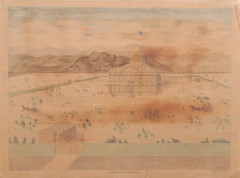
Picture of the main building of the Hokkaido Development Commission
This drawing was depicted by N.W. Holt. (from “Hokkaido in the Meiji and Taisho Era”)
The main building of the Hokkaido Development Commission was constructed in 1873. That stately building with an octagonal dome at the center was influenced by the American-Baroque style. It had been believed for a long time that the designer was N. W. Holt, an American engineer invited by the Development Commission. It was however later found that Yoshiyuki Adachi , a goyogakari official of the Development Commission, designed this building.
Adachi was born in Edo in 1827. He worked as a master-carpenter. When he turned 44, he was selected to the Building and Repairs Section, Accounting Bureau, Ministry of Engineering of the Meiji government. When he worked for the Development Commission, he was in charge of designing Hoheikan (Historical Guest House) and the Sapporo Clock Tower. We were surprised to learn how fast Japanese people in the Meiji era were absorbing Western architecture.
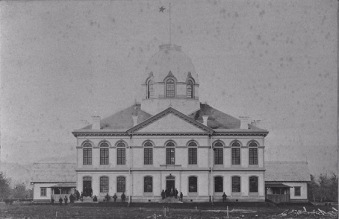
Main building of the Hokkaido Development Commission in Sapporo
The main building was photographed to commemorate its completion on October 29, 1873 (from “Hokkaido in the Meiji and Taisho Eras”)
The bricks used for the Former Hokkaido Government Office Building were burnt at Suzuki Brick factory and other brick factories operating in the suburbs of Sapporo called Shiroishi Village (current Shiroishi ward, Sapporo), where people found suitable soil for bricks. Flemish-bond brick laying, consisting of alternate laying of stretchers and headers produced its beautiful appearance. The Development Commission also adopted the Red-star mark image of the polar star as their symbol, and used it for decoration all over the building.
Seijiro Hirai later engaged in the construction of the Hakodate waterworks. After leaving Hokkaido, he actively participated in railway technology and assumed the position of the president of the Imperial Government Railways.
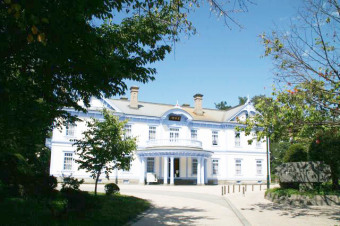
Hoheikan (Historical Guest House), designated an important cultural asset by the national government
Hoheikan built as a hotel under the direct management of the Development Commission in 1880 has been designated an important cultural asset by the national government. It was designed by Yoshiyuki Adachi who also designed the first Hokkaido government building, and construction was undertaken by Sukeemon Okawa. It is basically American/Western style, but Japanese motifs are incorporated throughout the building. (Photo courtesy of Sapporo City)
*It will be closed for conservation and repair works until March 31, 2016. (Estimated date)
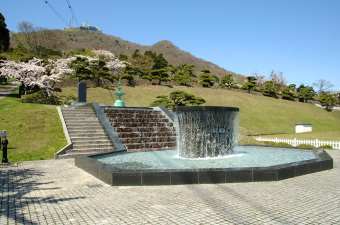
Motomachi Water Distribution Station
It was established in 1889 as the second waterworks facility in Japan after the one in Yokohama. The construction was supervised by Seijiro Hirai, who had designed the Former Hokkaido Government Office Building. (Photo courtesy of Hakodate Film Commission)
Historical Village of Hokkaido
Buildings displaying the history of lifestyle and industry, economy, and culture during each stage of Hokkaido development were relocated, restored and conserved in this outdoor museum. Scenes from the development era are reproduced and exhibited so that visitors can become familiar with the history of Hokkaido development.
- AddressKonopporo 50-1, Atsubetsu-cho, Atsubetsu-ku, Sapporo
- Tel.011-898-2692
- LinkHistorical Village of Hokkaido
Former Temiya railway facility
The railway facility has been maintained inside and around the former Temiya station premises, and consists of engine houses No. 1 and No. 3, a turntable, a water tank, a storage warehouse for dangerous objects , breast walls, etc. The exhibits include SL Shizuka-go, which the Development Commission purchased from the U.S., and SL Taisho-go, the oldest SL remaining in Japan.
- AddressTemiya 1-chome, Otaru
- Tel.0134-33-2523 (Otaru Museum)
- LinkFormer Temiya railway facility(In Japanese)
Inherited engineers’ spirit
The Development Commission and the Hokkaido Government Office, which subsequently took over the administration of the Development Commission, were the cradle of Seijiro Hirai and other engineers who strived for Hokkaido development.
During the development era, many foreign engineers directed development. They were Horace Capron, advisor to the Hokkaido Development Commission; Benjamin S. Lyman , who conducted geological surveys; Edwin Dun, who laid the foundation of Hokkaido agriculture; N.H. Holt, who was an industrial engineer; and Joseph U. Crawford, a railway engineer. There were 76 employed foreigners in total, and two thirds of them were from the U.S.
On the other hand, the Development Commission considered nurturing of Japanese engineers as their biggest challenge. Skilled personnel with techniques and knowledge were gathered, even if they were former retainers of shogun. They included Takeaki Enomoto, Keisuke Otori and Ikunosuke Arai, who had fought in the Hakodate War, Tokusaburo Yamauchi, who was an apprentice of Lyman, and Naritoyo Fukushi, a pioneer of Japanese meteorological observation.
The Development Commission also sent many young people abroad to study, and also established the Sapporo Agricultural College (current Hokkaido University) in 1876 as a place for personnel training. Besides teaching civil engineering, dynamics and mathematics at the Sapporo Agricultural College soon after its foundation, William Wheeler conducted surveys and measurement of canals, roads and road construction around the Sapporo area as a development engineer. He later took over Clark’s position of second Vice-Principal.
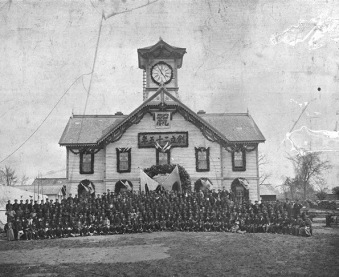
Teachers, students, graduates and guests at the 25th anniversary ceremony of the Sapporo Agricultural College (in front of the drill house)
The photo was taken in 1901 in front of the drill house of the Sapporo Agricultural College (present-day Clock Tower) (from “Hokkaido in the Meiji and Taisho Eras”).
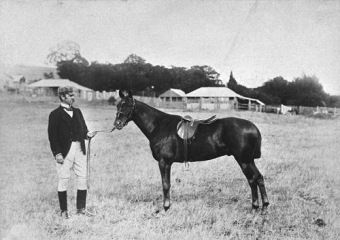
Edwin Dun and an imported horse at Makomanai Farm
Edwin Dun, who came to Japan in 1873, worked for dissemination of livestock farming in Hokkaido. The photo was taken around 1877 (from “Hokkaido in the Meiji and Taisho Eras”).
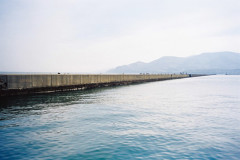
North breakwater of Otaru Port
The 1,289-meter long, 7.3-meter wide breakwater protects Otaru Port from the rough waves of the Sea of Japan. At the time of construction, Dr. Isamu Hiroi made more than 60,000 concrete specimens to test. This test, which is still being conducted and is known as the “100-year test” is attracting attention of concrete engineers all over the world. (Photo courtesy of Hokkaido Branch, Japan Society of Civil Engineers)
Bunkichi Okazaki, an engineer of the Hokkaido Government Office, was Hiroi’s student when Hiroi was a professor at the Department of Civil Engineering, Sapporo Agricultural College. After unprecedented heavy flooding of the Ishikari River in Hokkaido in 1898, Okazaki decided to undertake flood control of the Ishikari River. He advanced with research on flood control and took leadership for planning it. He assumed the position as the head of Ishikari River Flood Control Office, facing this difficult task. He was later called the Founder of Ishikari River flood control. Naturalism concerning his thoughts on flood control, “see nature as a teacher and learn from the cases that nature presents,” is still being highly appreciated.
Sapporo Clock Tower, designated an important cultural asset by the national government, former drill hall of the Sapporo Agricultural College
It was built in 1878 as the main auditorium of the Sapporo Agricultural College. Sapporo ward (current Sapporo City) purchased this building from the Sapporo Agricultural College in 1906. It was then moved approximately 100 meters south due to road maintenance. The prior chapter of the Sapporo Citizens’ Charter enacted in 1963 says, “We the citizens of Sapporo, where the chimes of the Clock Tower can be heard…” This shows that it has been cherished as a symbol of Sapporo.
- AddressKita 1-jo Nishi 2-chome, Chuo-ku, Sapporo
- Tel.011-231-0838
- LinkSapporo Clock Tower, designated an important cultural asset by the national government, former drill hall of the Sapporo Agricultural College
Edwin Dun Memorial Museum
Edwin Dun built this museum in 1880 as a cattle ranch office for the Development Commission. This building was originally constructed in Makomanai, Minami ward, but in 1964 it was transferred to the current address in the Edwin Dun Memorial Park. It is open to the public to remember Dun’s achievements.
- AddressIzumi machi 1-chome, Makomanai, Minami-ku, Sapporo
- Tel.011-581-5064
- LinkEdwin Dun Memorial Museum(In Japanese)




